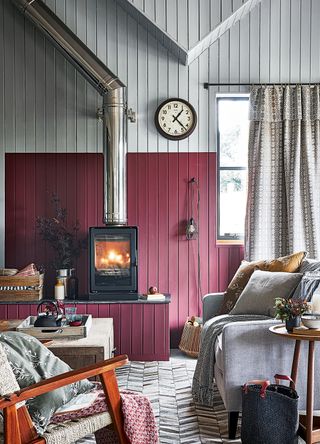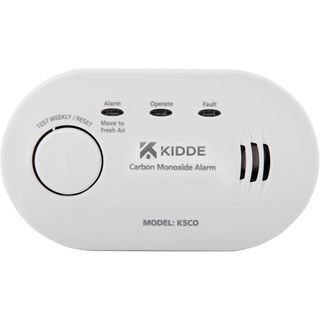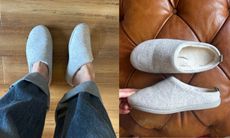'What I wish I had known before buying a log burner for my home' reveals an interior expert
Make sure you know what to expect before installing a log burner with our insider's experience


Log-burning stoves have become increasingly popular in recent years and show no sign of falling out of favour any time soon. Not only are these stoves a fantastic way to heat a space, but they also require no gas, oil or electricity so won't add to your household bills.
In my house, a renovated Edwardian cottage, we chose to install a log burner in the dining area of our open-plan kitchen, diner and snug and we love not only the way it looks nestled into the newly formed opening it sits in, but also how quickly it warms up the whole space when lit.
That said, there are definitely certain aspects of living with a log burner that I wasn't prepared for – good and bad.
If you are looking for ways to keep your house warm, then installing a log-burning stove should be one of the top things on your to-do list. But before you rush ahead, let me share with you the things I wish I'd known before having ours fitted to prevent any unwelcome surprises.
What you need to know before buying a log burner
There are certain things to be aware of when looking to make your home cosy by installing a log burner. One of the first questions homeowners tend to ask when thinking of adding this kind of stove is 'Do I need a chimney?'
Happily, even those homes with no chimney can usually be fitted with a log burner, although it will still be necessary to provide a way to take the fumes outside.
Instead, you will need to fit a twin wall flue system, which will take fumes and smoke out through the roof or an external wall of your house. This is essentially made up of several stainless steel pipes that connect to one another in order to carry your stove fumes outside.
Sign up for the woman&home newsletter
Sign up to our free daily email for the latest royal and entertainment news, interesting opinion, expert advice on styling and beauty trends, and no-nonsense guides to the health and wellness questions you want answered.
Additionally, if you live in a Smoke Control Area, you will need to select a DEFRA-approved stove or burn an 'authorised fuel'. You can find more information on this at ww.gov.uk.

A log burner can be a beautifully cosy focal point in a living room
What I wish I'd known before installing a log burner
I should start by saying that the entire family (especially the cat) loves our log burner. I work from home and am often reluctant to have the central heating blasting out all day to save energy around the home, but with the log burner smouldering gently away, the entire ground floor feels the benefit and the amount of clothing layers I have to put on is significantly reduced.
That said, there are a few things that surprised me about being a log burner owner too – from aspects such as maintenance, to heat output – and that's what I'm here to share with you.

Our stove, which has been in place for around eight years, is by Esse
Log burner heat output
Although I've mentioned how much I appreciate the amount of heat the log burner kicks out on a chilly day, without wishing to complain, there are times when it can be a little too hot. I wonder if this is, in part, down to the fact that we chose a log burner a little bigger, and with a greater heat output than we needed.
Heat aside, size also matters in terms of small living room layout rules – you don't want your stove encroaching too much on the space you have available.
“Getting the right size for your room is one of the most important factors to consider when buying a wood burner," says Joanna Humphreys, fire and stove specialist at Direct Stoves. "Too small, and it won't heat the room enough, leading to a lot of fuel waste and the risk of overfiring (when the fire burns too hot for the stove) and, therefore, damage. Too big, and the room will be uncomfortably hot, plus there is the risk of causing heat damage to painted walls, resulting in paint peeling away from the wall.”
In order to choose the correct size stove for your room, keep in mind that every 14m³ of space needs around 1kW if you want to achieve a comfortable temperature. In order to estimate the heat output you need, simply divide the cubic metres of the room (length x width x height) by 14.

Joanna is an expert in fires and stoves at Direct Stoves, a supplier of high-quality stoves that was established 2004.

Cleaning and maintenance
Don't be fooled into thinking that by opting for a log burner instead of an open fire you can sit back and enjoy the soft flicker of flames without putting in any routine maintenance.
If I want my log burner to look its best and run efficiently, I need to give it a good clean after every couple of uses. This means cleaning the glass in its doors, emptying the ash pan and checking the seals. My husband also sweeps the chimney once a year.
"Regular chimney sweeping is essential for preventing dangerous blockages and reducing the fire risk in your chimney," points out Joanna Humphreys. "It can also help to maintain correct airflow and improve the efficiency of your stove. Plus, it will help expand your chimney's lifespan and prevent expensive repairs.”
I find that using paper kitchen towels and a specialist cleaner for the doors, before wiping them over with a damp cloth, gets them looking super sparkly. That said, some people swear by using old newspapers and the ash from inside the stove to clean the glass. Just ensure you don't scratch the glass while cleaning.

RRP: £9.25 | This easy-to-use spray cleaner from HG is brilliant at removing soot, grease and tar from log burner glass. Simply spray it on, leave for up to five minutes then wipe it away. Another bonus is that it can also be used to remove soot from bricks on the fire surround.

RRP: £22.99 | This is a fantastic product to keep your chimney or flue clean and to make it easy to remove deposits when the time comes to have it swept. It comes as a tub of granules that you add a scoop or two of to the fire. As it burns it works to dry tar and creosote deposits.
Safety requirements
I am ashamed to say that I was unaware that we would need a carbon monoxide detector in order to have a log burner in our home, yet fitting a carbon monoxide (CO) detector is a requirement of the building regulations when installing or replacing a gas fire or stove.
"Carbon monoxide alarms are often removed after installation and air bricks covered to minimise draughts," reveals Jon Butterworth. "Both these things are vitally important to a safe installation.”

This neat little carbon monoxide detector and alarm can be wall-mounted or used as a freestanding device — making it perfect for renters. It has a reassuring 10-year alarm life too.
Colour options

Our Esse log burner is a classic black and I have to say that I don't have a problem with this as it sits nicely with our decor and in no way tries to steal the limelight. That said, if I were choosing a new stove now I think I might be tempted to go for a coloured design instead. I don't think I was aware at the time how many options there are out there and how they could have helped elevate our dining room interior ideas.
“Knowing that a coloured wood burning stove is an option is often forgotten about,' says Jon Butterworth, director at Arada Stoves. "A wood burner needn’t always be black. Although a timeless and traditional choice for many, we suggest choosing a bold shade and adding a pop of colour with a brightly painted stove.
"Greens, reds and oranges make a real statement in a living room, especially during the summer months, and homeowners can truly personalise their space and create a show-stopping interior.”
Personally, I love cream and white log burners for the cosy Scandi vibe they add to a space.

Jon is director at Arada Stoves, a British company that was formed over 40 years ago in Devon and which now manufactures and distributes wood, multi-fuel, gas and electric stoves and fires.
Log burner fuel storage

Don't forget to consider that you will need somewhere to store your logs if you are going to have a wood burning stove. This means providing a spot for keeping kindling and firewood close to the stove as well as a larger store externally to keep you going throughout the winter.
“Storage for wood and kindling is often overlooked," says Jon Butterworth. "People fill the fireplace with an appliance and are then left wondering where to put the fuel to use it."
You could invest in a stylish log basket or bucket to place on your hearth, or use a more modern log rack. Externally, there is a good range of of log stores out there, from those that come flat-packed to designs that can come built, ready to fill with firewood.
"You could also build wood storage into the wall — or choose an appliance with an integral log store,” suggests Jon Butterworth
 Kindling compartment
Kindling compartment
RRP: £169 | This brilliant log rack combines classic good looks with practical design. The small bottom compartment is perfect for storing kindling, while the upper section will allow you to stack logs neatly, all while taking up minimal hearth space.

RRP: £75 | This felt storage solution is ideal for those who want an alternative to the traditional woven basket. The Scandi-inspired design is made using 100% sheep wool.

RRP: £200 | If you have the space an outside storage solution is a great idea to stockpile logs to ensure you don't run out when you need heat the most.
FAQs
Are there any disadvantages of having a log burner?
As with everything, there are a few downsides when it comes to owning a log burner. If you want to know exactly what you are stepping into by installing a log burning stove, be aware that:
- They require regular cleaning and your chimney will need sweeping
- A twin-walled flue system will be required if you don't have a chimney
- You will need to keep stocked up on kindling and firewood
How much do log burners cost?
The cost of a log burners varies hugely depending on the size of the appliance and your supplier.
They range from around £500 right up to more than £3,000 for freestanding and double-sided models, or those that include log storage or are more like works of art than stoves.
Can I install my own log burning stove?
While you can legally install a log burner on a DIY basis, there are a few considerations to bear in mind.
You will need the correct tools for the job and you must notify your local Building Control officer of the work so that they can visit your home to inspect the work to ensure it complies with building regulations.
If, on the other hand, you enlist a HETAS-approved installer to carry out the work, they will fit it in accordance with the regulations and issue you a certificate.

Natasha Brinsmead is a freelance homes and interiors journalist with over 20 years experience in the field. As former Associate Editor of Homebuilding & Renovating magazine, Natasha has researched and written about everything from how to design a new kitchen from scratch to knocking down walls safely, from how to lay flooring to how to insulate an old house. She has carried out a number of renovation projects of her own on a DIY basis and is currently on the lookout for her next project.
-
 Goodbye premium prices - these M&S slippers have become my new indoor go-to
Goodbye premium prices - these M&S slippers have become my new indoor go-toFor £19.50, these are a wardrobe must-have that you'll reach for daily
By Molly Smith Published
-
 Zara Tindall and Princess Eugenie twin in maroon at Cheltenham as they show how occasionwear styling is done
Zara Tindall and Princess Eugenie twin in maroon at Cheltenham as they show how occasionwear styling is doneRoyal cousins Zara Tindall and Princess Eugenie were on the same page with their Cheltenham outfits and their approach is worth following
By Emma Shacklock Published